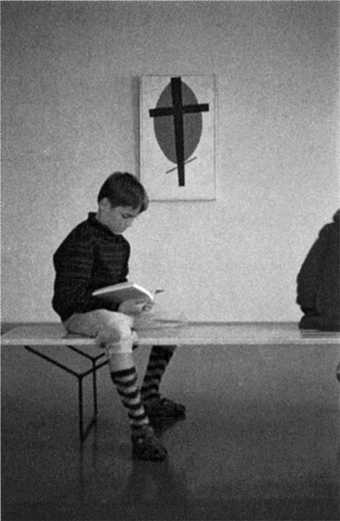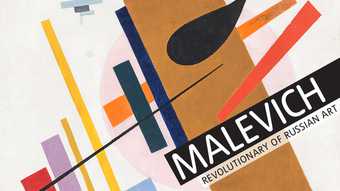
Wolfgang Laib, aged eight, at Ulm Museum sitting in front of Malevich’s Mystic Suprematism (black cross on red oval) 1920-2, photographed by his father
Courtesy Wolfgang Laib
When I look back I’m really surprised how Kazimir Malevich influenced my life and that of my family. The architect Hugo Häring was a friend of Malevich. When the artist had to leave Berlin for Russia in 1927, he left a number of paintings with Häring to pick up on his return – but he never came back. When the Second World War broke out and Berlin became very dangerous, Häring took the paintings with him to Biberach, near Munich, which was a relatively safe place. Here he stored them rolled up under his bed. He soon got to know a local landscape painter called Jakob Bräckle, and they would occasionally unroll and enjoy them together.
When my parents moved to the area and my father opened an orthopaedic practice in 1958, he became a friend of Bräckle, who told them the stories about the paintings. I would get a chance to see them when I went with my parents to a Malevich exhibition at Ulm Museum. There is a funny photograph of me, with my notebook and stripy socks, taken by my father, sitting as an eight-year-old boy in front of Malevich’s Mystic Suprematism (black cross on red oval) 1920–2.
For a long time afterwards there were endless discussions between my parents and Bräckle about the show and, in particular, Suprematist Composition: White on White 1918. In the family it became an icon and Malevich a semi-god. I certainly feel that the exhibition led my father to want to build a house for us - which became the glass house in which I now live. This simple house, inspired by these conversations, had a strong impact on my family’s thinking and way of life, which continues today.
People compare my works such as Milkstone 1978 or Pollen from Pine 1998 with White on White, but the influence is much more subtle and complex than appearances would suggest. Malevich had this very strong vision of his art. It was the opposite of thinking that it was just decoration on the wall. It isn’t his work that has inspired me, but his approach – that art is the most important thing in life, and can enhance that life.

